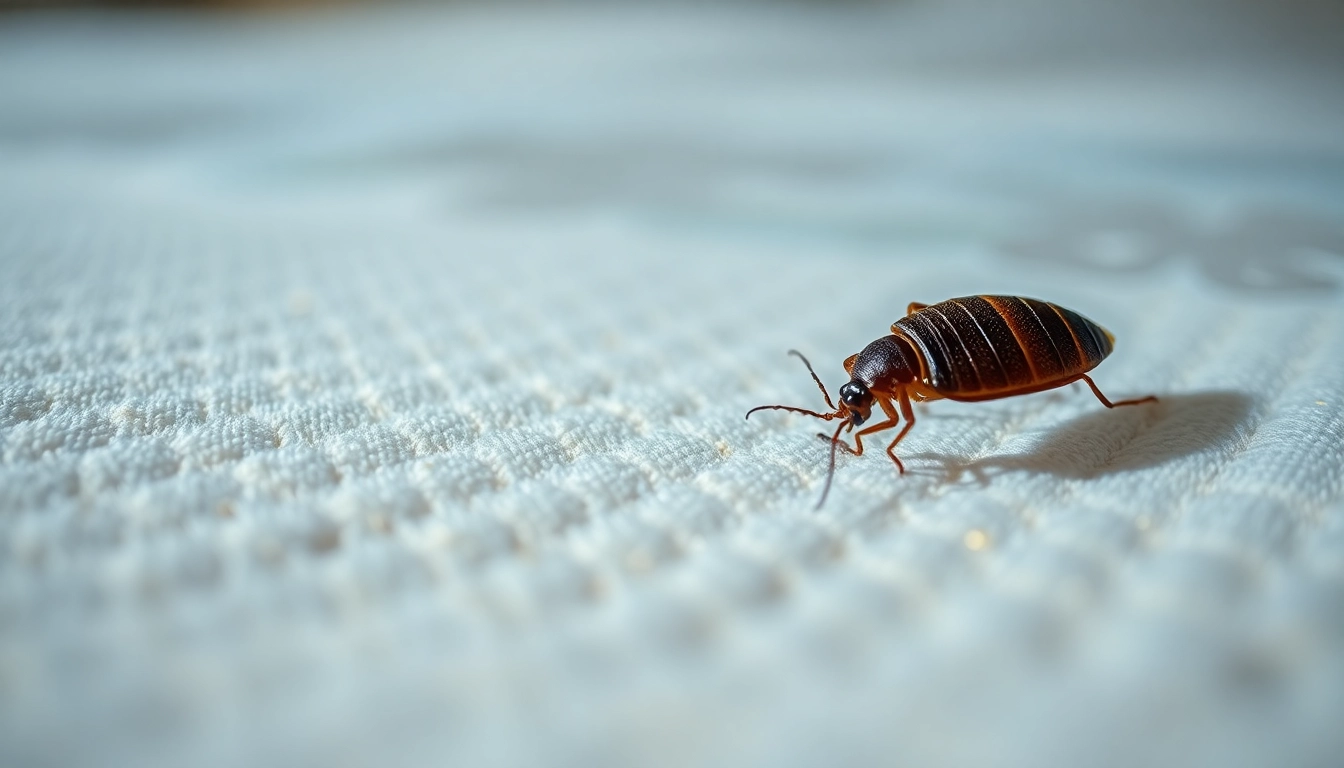Understanding Bed Bugs and Their Habits
What are Bed Bugs?
Bed bugs, scientifically known as Cimex lectularius, are small, nocturnal insects that feed on the blood of humans and animals. They are flat, oval-shaped, and usually brown in color, which allows them to blend into the seams and crevices of furniture, walls, and bedding. Adult bed bugs can grow to about 4-5 mm in length and are notorious for their ability to reproduce rapidly. Their presence is often associated with indoor environments, making them a significant issue for homeowners, renters, and travelers alike.
Signs of Infestation
Identifying a bed bug infestation early is crucial for effective control. Common signs include:
- Inspection for Bites: Small, itchy welts, often in a linear pattern, on exposed skin indicate possible bites from bed bugs.
- Visible Bugs: Adult bed bugs and their eggs can sometimes be seen in bedding, mattresses, or furniture.
- Dark Spots: Fecal stains or shed skins may appear on sheets, mattress seams, and furniture, signaling their presence.
- Unusual Odors: A musty smell in the infested area can be indicative of a larger bed bug population.
The Life Cycle of Bed Bugs
Understanding the life cycle of bed bugs is essential for effective bed bug control. Their life cycle consists of five distinct stages: egg, nymph, and adult.
Eggs are tiny, about 1 mm, and typically hatch within a week. Nymphs, after molting five times, grow into adults within 4-8 weeks, depending on environmental conditions. This rapid reproduction rate allows infestations to escalate quickly if not addressed promptly.
Comprehensive Bed Bug Control Techniques
Integrated Pest Management (IPM) Approach
The Integrated Pest Management (IPM) approach is an effective strategy that combines multiple methods for controlling bed bug infestations. This approach focuses on understanding the pest’s biology and behavior, utilizing a combination of non-chemical and chemical treatments while minimizing health risks to humans and the environment.
Key components of IPM for bed bug control include:
- Regular Monitoring: Constant inspection of sleeping areas and common hiding places helps catch infestations early.
- Sanitation: Keeping living areas clean and free of clutter reduces potential hideouts for bed bugs.
- Physical Controls: Using mattress encasements and traps can help manage bed bug populations effectively.
- Chemical Controls: When necessary, using pesticides labeled specifically for bed bugs as part of a comprehensive control strategy can be effective.
Natural Remedies for Bed Bug Control
While chemical treatments can be effective, some homeowners may prefer natural remedies. Though often less effective than pesticides, these methods can help manage minor infestations:
- Essential Oils: Oils like tea tree and lavender have pest-repellent properties.
- Steam Treatment: Applying steam at temperatures above 120°F can kill bed bugs and their eggs.
- Cold Treatment: Placing small items in a freezer for at least four days can eliminate bed bugs.
However, reliance solely on natural remedies often proves inadequate for severe infestations.
Chemical Solutions and Safety Precautions
Chemicals can play an important role in bed bug control. Common active ingredients in bed bug pesticides include pyrethroids and neonicotinoids. It is vital to use these products according to the manufacturer’s recommendations to ensure safety and efficacy.
Before applying any chemical solutions:
- Read the label carefully for safety information.
- Wear protective gear, including masks and gloves.
- Ensure proper ventilation during application.
- Keep pets and children away from treated areas until they are dry.
Preparing Your Home for Bed Bug Treatment
Decluttering and Cleaning
Before treatment begins, it is essential to declutter and clean the affected areas thoroughly. This includes:
- Removing items from the infested room and inspecting them for bed bugs.
- Washing all bedding and clothing in hot water followed by a high-heat dryer cycle.
- Vacuuming carpets, crevices, and upholstered furniture meticulously.
Decluttering not only reduces potential hiding spots for bed bugs but also makes the treatment process easier and more successful.
Pre-Treatment Inspection Steps
Proper inspection is key to identifying the extent of a bed bug infestation. Professionals typically conduct detailed assessments that include:
- Checking mattresses and bed frames, particularly seams and folds.
- Inspecting electrical outlets and wall voids.
- Examining furniture, especially areas where people spend extended amounts of time.
Homeowners can also undertake inspections using flashlights and magnifying glasses to assist with their evaluations.
How to Protect Your Belongings
Taking steps to protect your belongings during treatment is crucial. Here are some strategies:
- Seal affected items in plastic bags to prevent the spread of bed bugs during cleaning and treatment.
- Use bed bug-proof mattress encasements to trap and kill existing bed bugs.
- Store infested belongings in airtight containers until treatment and cleaning are fully complete.
Post-Treatment Maintenance and Prevention
Monitoring for Recurrences
After treatment, it is vital to monitor for any signs of bed bug re-infestation. This can involve:
- Regularly inspecting beds and furniture.
- Using bed bug interceptors under the legs of beds and furniture.
- Maintaining a cleaning routine to eliminate potential hiding spots.
Ongoing Preventative Measures
To prevent future infestations, consider these practices:
- Implementing good hygiene practices by regularly vacuuming and washing bedding.
- Being cautious when traveling—inspecting hotel rooms and placing luggage on luggage racks instead of beds or floors.
- Educating family members about bed bugs and their habits to raise awareness.
When to Call in Professionals
Professional pest management services may be necessary if:
- The infestation is extensive and cannot be managed through DIY methods.
- Previous treatments have failed to yield results.
- Health concerns arise from the use of pesticides or bed bug bites.
During these situations, expert exterminators can provide targeted treatments tailored to the specific conditions of your home.
Frequently Asked Questions about Bed Bug Control
Can I Treat for Bed Bugs Myself?
Yes, but treating bed bugs can be challenging. It requires a combination of cleaning, monitoring, and, often, the use of insecticides. Homeowners should be prepared to commit to consistent action to achieve effective control.
How Long Does Bed Bug Treatment Take?
The duration of bed bug treatment varies depending on the size of the infestation and the methods used. A complete treatment process can take several weeks to ensure all bed bugs and their eggs are eradicated.
Signs That Your Treatment is Working
Indications that your treatment is successful include:
- A decrease in the number of bed bug bites.
- Fewer sightings of live bed bugs in the monitored areas.
- A decline in the presence of shed skins and fecal matter.
Consistent monitoring and proactive measures will help maintain a bed bug-free environment.



